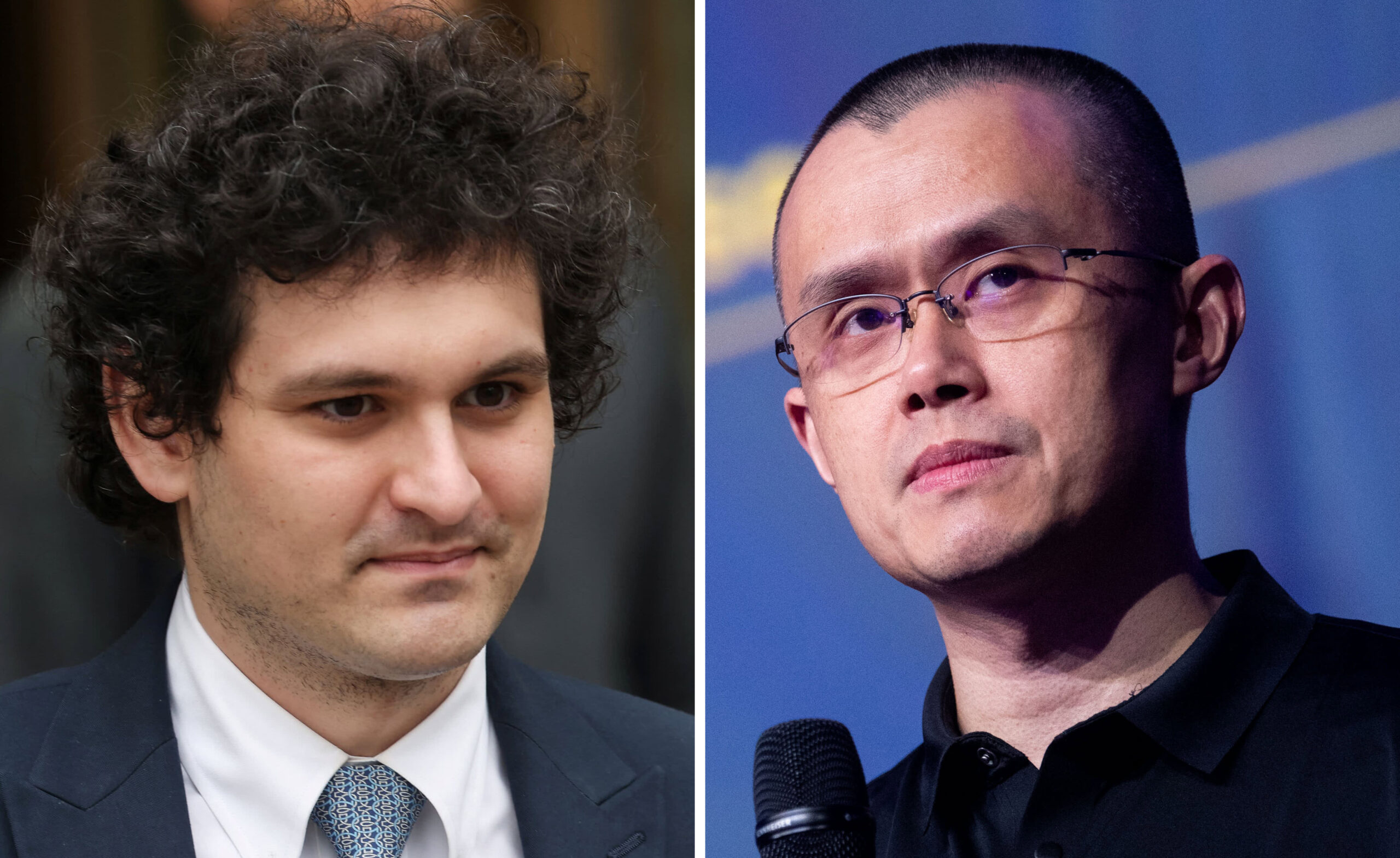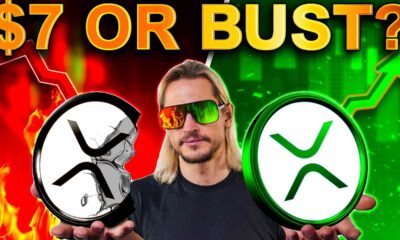News
Inside the final prison verdict on an epic crypto CEO rivalry

- A longtime battle between cryptocurrency titans was brought to a close in federal court this past week when Binance founder Changpeng Zhao was handed a sentence of four months in prison.
- The criminal judgment was in stark contract to the 25-year prison sentence FTX’s Sam Bankman-Fried received.
- The crypto kingpins shared a pulpit for years from which they preached the power of decentralized, digital currencies to the masses, but the difference in prison sentences highlights how they were nothing alike in business or in personal dealings.
Combination showing Former FTX CEO, Sam Bankman-Fried (L) and Zhao Changpeng (R), founder and chief executive officer of Binance.
Mike Segar | Reuters | Benjamin Girette | Bloomberg | Getty Images
An arch rivalry between one-time crypto titans was brought to a close at a federal courthouse in Seattle on Tuesday when Binance founder Changpeng Zhao was handed a sentence of four months in prison. A month earlier, on the opposite coast in downtown Manhattan, FTX’s Sam Bankman-Fried received a 25-year prison sentence for his crimes.
It seemed an underwhelming and somewhat anti-climactic finish to a protracted battle between Zhao and Bankman-Fried, two men who were legendary adversaries, as well as key stewards of the $2.2 trillion crypto sector.
For years, Binance’s Zhao and FTX’s Bankman-Fried preached the power of decentralized, digital currencies to the masses. Both were bitcoin billionaires who drove Toyotas, ran their own global cryptocurrency exchanges and spent much of their professional career selling the public on a new, tech-powered world order; one where an alternative financial system comprised of borderless virtual coins would liberate the oppressed by eliminating middlemen like banks and the overreach of the government.
Ultimately, both also helped crypto critics and regulators make the case that the skeptics had been right all along — the industry was rife with grifters and fraudsters intent on using new tech to carry out age-old crimes.
Bankman-Fried, 32, was convicted of seven criminal counts in early November, including charges related to stealing billions of dollars from FTX’s customers. Less than three weeks after Bankman-Fried’s conviction, 47-year-old Zhao pleaded guilty to criminal charges and stepped down as Binance’s CEO as part of a $4.3 billion settlement with the Department of Justice.
Yet, much else about the pair is starkly at odds — perhaps most notably, the 296-month difference in their respective prison sentences.
“Comparing CZ and SBF, both figures emerged as prominent in the cryptocurrency sector but under vastly different circumstances,” said Braden Perry, a former senior trial lawyer for the CFTC.
“The nature of their alleged crimes reflects different aspects of the ‘dark’ and illicit corners of crypto: CZ’s case seems to focus on regulatory and compliance failures, while SBF’s case hinges on direct financial misconduct and deception,” Perry said.
Indeed, the disparate consequences for the two former crypto CEOs lay bare that the pair was, in the end, nothing alike in business or in personal dealings.
It was the small things — the type of details that you don’t notice at first and are often difficult to articulate the significance of once you do — that betrayed the more notable differences between the two former CEOs.
Take Manfred, a worn stuffed animal that Bankman-Fried has carried around the world with him since birth, from California, to Hong Kong, to the Bahamas, and then back home to Palo Alto, where the FTX founder lived under house arrest until he was remanded to custody for tampering with witnesses.
The 32-year-old toy, which has lost much of its shape and identifying features, sat on the bed of his sparsely decorated room in his parents’ house on Stanford University’s campus in his final days before incarceration. It was a harmless prop at first glance, more a charming nod to an adolescent spirit than the sort of window into Bankman-Fried’s inner psyche that some of those who knew him would later attempt to turn it into.
Two of Bankman-Fried’s former colleagues and friends took turns at speculating on its meaning. One thought that SBF kept the stuffed animal close because “he doesn’t need to share Manfred with anyone,” according to reporting from “Going Infinite,” the Michael Lewis book that profiled Bankman-Fried. Another guessed, “I think it is very, very important for him to have an emotional attachment.”
Lewis himself writes that “Sam didn’t care about real animals” and that it had, in fact, been “an expected value calculation, rather than emotion, that had led him to go vegan.”
Bankman-Fried did have a history of intimacy issues. Part of it, according to his family, friends, work colleagues, criminal defense attorneys, and even Bankman-Fried himself, had to do with his inability to feel much of anything, for anyone, including romantic love interests.
FTX founder Sam Bankman-Fried leaves the U.S. courthouse in New York City on July 26, 2023.
Amr Alfiky | Reuters
His lawyers described him as often struggling socially, disclosing that in high school, Bankman-Fried “realized he was anhedonic, or unable to experience joy or pleasure.”
“As Sam describes it, he experiences negative emotions in ways that are not very different from many other people — neither much more extreme, nor much less negative. But he does not feel pleasure, or happiness, or joy, even when something very good happens to him,” a court filing in SBF’s criminal court docket reads.
Lawyers for Bankman-Fried added that it was not a disease or condition to be “cured,” but instead, “a fundamental aspect” of his identity. Lewis relayed an exchange with SBF in which Bankman-Fried said that smiling was the biggest thing that he “most weirdly” couldn’t do.
Bankman-Fried never married, has no children, and according to Lewis, moved himself and his company headquarters to the opposite side of the planet, twice, partly to avoid committing to his ex-girlfriend, ex-colleague, and the prosecution’s star witness against him: Alameda CEO Caroline Ellison.
The government’s case against him — which resulted in a unanimous guilty verdict in just a few hours despite it being a complicated month-long trial involving hundreds of exhibits and nearly 20 witnesses — was largely built upon the testimony of the people who knew Bankman-Fried best. The list included his former C-suite, ex-roommates, and ex-best friends going back to high school.
And so, Manfred took on new meaning, and began to embody much of what appeared to onlookers as a very lonely existence, in which the people closest to Bankman-Fried were the ones to seal his fate behind bars.
While Bankman-Friend’s parents were staunch defenders of their son in court, CZ, by contrast, had many who know him best leap to his defense. Zhao’s wife, his current lover, two of his five children, and dozens of Binance employees all penned the judge to plead for mercy in sentencing.
“I am a partner in the work of Changpeng Zhao (abbreviated CZ) and I am also the mother of his three children,” reads a note submitted by Yi He, a co-founder of Binance and Zhao’s current romantic partner. “Although the mainstream media tries to portray CZ as an evil bad actor, millions of community users and ordinary people regard him as a hero of the industry, because CZ has always insisted on justice.”
Changpeng Zhao, former CEO of Binance, arrives at federal court in Seattle, Washington, April 30, 2024.
David Ryder | Bloomberg | Getty Images
Zhao’s wife, Weiqing “Winnie” Yang called him a “self-made man” who “has never owed money to others and has not had any liabilities.” Yang added that Zhao has “taken the greatest care” of her and their shared children. Their daughter, Rachel Zhao, implored the judge “to consider her father’s positive attributes; to not define my father’s character solely through this one incident and consider the entirety of his character,” emphasizing that he was “the best father.”
Differences between the pair also showed up in the way they presented themselves.
Whereas Zhao maintained a military-style buzzcut, Bankman-Fried was known for his iconic and unwieldy mop of curls. CZ bought clothes on Amazon, but his look and demeanor were buttoned-up. SBF, who similarly opted for simple dress (usually a loose T-shirt and cargo shorts), appeared perpetually disheveled, whatever the occasion. At the beginning of his trial, SBF sported a fresh haircut and wore suits, but by its end, his curls were wild again. Zhao wore a fitted navy suit and light blue tie at his sentencing, versus the beige jailhouse jumpsuit donned by Bankman-Fried.
But perhaps the greatest distinction between the two relates to the command they held over those around them.
Zhao had an air of the consummate professional, with a strong appetite for total control of his sprawling enterprise. Bankman-Fried, who takes medication for the neuro-developmental disorder attention-deficit/hyperactivity disorder, sought a similar level of control, but admitted on the stand that mistakes were made, in part, because he was overwhelmed. Bankman-Fried’s psychiatrist unequivocally made clear to the judge that without prescribed medication, Bankman-Fried would experience a return of his symptoms and be “severely negatively impacted in his ability to assist in his own defense.”
Reuters reporting found that even as CZ’s crypto exchange diversified its hiring into traditional finance and regulatory talent pools, “Zhao’s tight control over his company was undiminished.” Binance set up more than 70 entities, and according to Reuters, Zhao personally controlled most of them.
Cryptocurrency exchange Binance founder and CEO Changpeng Zhao speaks at a Binance fifth anniversary event in Paris, France, July 8, 2022.
Staff | Reuters
Prosecutors similarly proved through testimony and evidentiary exhibits their narrative of Bankman-Fried quietly continuing to call the shots at his crypto hedge fund, Alameda Research. They showed that his decision-making power over the $32 billion crypto empire he built was absolute, and that all wrongdoing stemmed from decisions touched, or directly made by, Bankman-Fried himself. But unlike CZ, Bankman-Fried oversaw an organization with chaotic and falsified bookkeeping that ultimately led to the implosion of the companies he founded and the theft of billions of dollars of customer money.
And then there was the way that each looked to craft their public persona.
CZ was big on privacy. The letters submitted by his romantic partners and children were a rare inside look at Zhao’s personal dealings. And rather than take to mainstream media to share his defense, CZ clammed up and cooperated with the feds.
Shirking the advice of all counsel, Bankman-Fried went on a media blitz to talk about the implosion of his crypto empire. Many of those statements ultimately appeared in the government’s successful trial against him in October and November 2023.
“SBF resolutely did not settle, violated his bail conditions, spoke frequently to the press in his own favor and seemed to lack a display of genuine, heartfelt remorse even at his own sentencing,” said Yesha Yadav, law professor and associate dean at Vanderbilt University.
“Part of CZ’s deliberations in settling with Justice in November may have been precisely to make this point – that his conduct stands profoundly in contrast to the brazen behavior of SBF,” Yadav added.
In Seattle, Zhao’s sentencing was a relatively quiet affair, with a vibe that was more muted than the circus surrounding Bankman-Fried’s time in court.
“This proceeding looked and felt like the prosecution of a Wall Street executive,” said Mark Bini, a former state and federal prosecutor.
Zhao also expressed his remorse, accepting responsibility for his crimes and telling the judge he was sorry for his actions. It stood in stark contrast to Bankman-Fried’s final appeal to the judge, which lacked any sort of real admission of guilt.
Judge Lewis Kaplan, who sentenced Bankman-Fried to 25 years in prison, noted during his sentencing hearing that he had never heard “a word of remorse for the commission of terrible crimes” from Bankman-Fried and that in his 30 years on the federal bench, he had “never seen a performance” like SBF’s trial testimony.
If Bankman-Fried was not “outright lying” during cross-examination by prosecutors, he was “evasive,” Kaplan said.
“Instead of accepting responsibility, Bankman-Fried pushed his case to trial where he lied and perjured himself and was convicted by overwhelming evidence,” former federal prosecutor Neama Rahmani told CNBC.
To be sure, the Zhao and Bankman-Fried cases are very different.
While much of Bankman-Fried’s empire was a mirage, Zhao’s operation was laced with questionable business tactics under the hood.
Bankman-Fried and other leaders at FTX took billions of dollars in customer money. In fact, during the criminal trial of Bankman-Fried, both the prosecution and defense agreed that $10 billion in customer money that was sitting in FTX’s crypto exchange went missing, with some of it going toward payments for real estate, recalled loans, venture investments and political donations. They also agreed that Bankman-Fried was the one calling the shots.
The key question for jurors was one of intent: Did Bankman-Fried knowingly commit fraud in directing those payouts with FTX customer cash, or did he simply make some mistakes along the way? Jurors decided within a few hours of deliberation that he had knowingly committed fraud on a mass scale.
The government’s beef with Zhao and Binance was different.
Perry said that the connection with foreign crime, including money laundering and breaching international financial sanctions, was key to Binance’s undoing. There was, however, no pursuit of criminal fraud of its customers’ money — a key distinction from the case of Bankman-Fried.
Instead, three criminal charges were brought against the exchange, including conducting an unlicensed money-transmitting business, violating the International Emergency Economic Powers Act, and conspiracy. Binance agreed to forfeit $2.5 billion to the government, as well as to pay a fine of $1.8 billion, for crimes which included allowing illicit actors to make more than 100,000 transactions that supported activities such as terrorism and illegal narcotics.
Zhao and others were also charged with violating the Bank Secrecy Act by failing to implement an effective anti-money-laundering program and for willfully violating U.S. economic sanctions “in a deliberate and calculated effort to profit from the U.S. market without implementing controls required by U.S. law,” according to the Justice Department. The DOJ is recommending that the court impose a $50 million fine on Zhao.
Zhao turned a blind eye to money laundering, explains Rahmani, but he pleaded guilty and accepted responsibility for his actions. Bankman-Fried, on the other hand, stole money from clients and used them for lavish personal expenses.
“That’s why Bankman-Fried received a significantly longer prison sentence than Zhao,” Rahmani said.
Los Angeles corporate law attorney Tre Lovell said that, unlike Bankman-Fried, who was convicted of fraud, Zhao hasn’t been charged with fraud or other crimes deserving of a longer sentence.
“In addition, his letter to the judge does reflect remorse, discusses his making of poor decisions, and indicates that the Binance platform has instituted strict anti-money laundering controls at his direction,” Lovell said.
“SBF’s case involved allegations of fraud and misuse of customer funds, which are typically viewed as more directly deceitful and financially damaging to a broader array of individuals than compliance failures (like inadequate AML programs),” Perry said. Compliance failures, while serious, might be seen as a failure of oversight rather than active malfeasance, according to Perry.
“Fraudulent actions directly undermine trust and suggest intentional wrongdoing, which can lead to harsher public and judicial responses,” he added.
Unlike SBF, CZ didn’t have his wealth wiped out by bankruptcy of the crypto company he founded. And as he cooperated with the government and pleaded guilty, his assets weren’t seized.
Despite the fact that Zhao is being put behind bars, his controlling stake in Binance means that he will continue being one of the wealthiest people in crypto today. Zhao is widely reported to have an estimated 90% stake in Binance, and his fortune is largely derived from his equity ownership in the company.
Binance is by far the world’s largest cryptocurrency exchange by trading volume, processing $18.1 trillion worth of trading volume in 2023, according to data from crypto market data firm CCData. And even though Binance has seen its market share drop to 41.6% since Zhao stepped down as CEO in November 2023, the company remains the dominant player overall — leagues ahead of South Korean exchange Upbit, Dubai-headquartered Bybit, and U.S. giant Coinbase.
While Binance has been convicted of extremely serious charges, it still remains a lucrative operation, according to Yadav. Binance is profitable and solvent, meaning that it has a hefty war chest to settle fines.
FTX, on the other hand, remains in bankruptcy court in Delaware.
“FTX has been revealed to have been a criminal enterprise that is now headed into liquidation owing to its assessed inability to salvage any brand and use value,” Yadav said.
Notably, because Zhao pleaded guilty to only one count of violation of the U.S. Bank Secrecy Act (BSA), he is regarded as a first-time offender and thus reached a settlement with federal authorities to step down as CEO and not relinquish his interest in the company or have assets frozen.
“Typically, personal assets that are not directly linked to the criminal activity might remain unaffected,” Perry said. “His assets could also be managed on his behalf while he is incarcerated.”
That’s a different situation from Sam Bankman-Fried, who saw his wealth reduced to zero after his crypto empire collapsed into bankruptcy in 2022.
“In relation to CZ’s personal wealth … he would still be able to retain his share in Binance, as well as maintain his crypto holdings which also contribute an unknown, yet material, amount to his overall wealth and net worth,” Joshua de Vos, research lead at CCData, told CNBC via email. “Since there is no misappropriation or bankruptcy proceedings, it is highly unlikely that CZ would see his wealth reduced to zero as was the case with SBF,” de Vos said.
As for what’s next, new FTX CEO John Ray III and his team of restructuring advisors continue their effort to claw back cash, luxury property, and crypto, to try to make customers whole. Bankman-Fried, meanwhile, is appealing the verdict.
Zhao said in a court filing that his future ambition lies in bringing blockchain tech to biotech startups.
Binance isn’t out of the woods yet. The Securities and Exchange Commission was notably absent from the exchange’s $4.3 billion settlement with the U.S. government. Meanwhile, two of its employees remain in jail in Nigeria awaiting trial for alleged crimes committed by the exchange.
— CNBC’s Ryan Browne contributed to this report.
News
Cryptocurrency Price August 1: Bitcoin Dips Below $65K; Solana, XRP Down Up To 8%

Major cryptocurrencies fell in Thursday trading following the Federal Reserve’s decision to keep its key interest rate unchanged. Overnight, the U.S. Federal Reserve kept its key interest rate at 5.25-5.5% for the eighth consecutive time, as expected, while also signaling the possibility of a rate cut at its next meeting in September. The unanimous decision by the Federal Open Market Committee reflects a continued wait-and-see approach as it monitors inflation trends.
CoinSwitch Markets Desk said: “Bitcoin has fallen below $65,000 after the US Federal Reserve announced it would keep interest rates unchanged. However, with markets now anticipating rate cuts at the next Federal Reserve meeting in September, the outlook for a Bitcoin rally by the end of the year has strengthened.”
Meanwhile, CoinDCX research team said: “The crypto market has plunged after the Fed decision. Tomorrow’s US unemployment rate announcement is expected to induce more volatility, with the ‘actual’ figure coming in higher than the ‘expected’ one, which is positive for cryptocurrencies.”
At 12:21 pm IST, Bitcoin (BTC) was down 3.2% at $64,285, while Ethereum was down nearly 4.5% at $3,313. Meanwhile, the global market cryptocurrency The market capitalization fell 3.6% to around $2.3 trillion in the last 24 hours.
“Bitcoin needs to clear its 200-day EMA at $64,510 to consolidate further. Otherwise, a retest of $62,000 could be in the cards,” said Vikram Subburaj, CEO of Giottus.
Altcoins and meme coins, such as BNB (3%), Solana (8%), XRP (5.7%), Dogecoin (5%), Cardano (4.6%), Avalanche (4.3%), Shiba Inu (3.8%), Polkadot (3.4%), and Chainlink (4%) also saw declines.
The volume of all stablecoins is now $71.64 billion, which is 92.19% of the total cryptocurrency market volume in 24 hours, according to data available on CoinMarketCap. Bitcoin’s dominance is currently 54.99%. BTC volume in the last 24 hours increased by 23.3% to $35.7 billion.
(Disclaimer: Recommendations, suggestions, opinions and views provided by experts are personal. They do not represent the views of the Economic Times)
(You can now subscribe to our ETMarkets WhatsApp Channel)
News
Altcoins WIF, BONK, RUNE, JUP Down 10% While Bitcoin Drops 4%

Altcoins dogwifhat, Bonk, THORChain, and Jupiter have suffered losses of more than 10%, while Bitcoin is down 4% in the last 24 hours.
After a period of relative calm yesterday, July 31, Bitcoin (BTC) price action has seen a drastic change as the cryptocurrency dropped by more than $3,500, bringing its value to $63,300. At the same time, altcoins mirrored this trend, with the total value of liquidated positions rising to nearly $225 million over the course of the day.
Initially, the week started on a positive note for Bitcoin, which reached its highest point since early June, hitting $70,000. However, this peak was short-lived, as it was quickly rejected, leading to a substantial decline, with Bitcoin falling below $65,500.
The cryptocurrency managed to regain some stability, trading comfortably at around $66,800. However, following a Press conference According to Federal Reserve Chairman Jerome Powell, the value of Bitcoin has fallen again to $64,300, down more than 3% in 24 hours.
BTC Price Chart 24 Hours | Source: crypto.news
The recession coincided with a relationship from the New York Times stating that Iran had called for retaliatory measures against Israel following the assassination of Hamas leader Ismail Haniyeh in Tehran, increasing the risk of further conflict in the region.
Meanwhile, on the economic front, the Federal Reserve decided to keep its benchmark interest rates in place, offering little information on a planned September rate cut. Powell also hinted that while no concrete decisions have been made on the September adjustment, there is growing consensus that a rate cut is likely.
Amid Bitcoin’s decline, altcoins have suffered even more significant losses. For example, dogwifhat (Wife) saw a 12.4% drop and (DISGUST) has suffered a 10% drop. Other altcoins such as THORChain (RUNE) also fell by 10%, while Jupiter (JUPITER) and the Ethereum naming service (ENS) decreased by 8% and 9% respectively.
Among the largest-cap cryptocurrencies, the biggest losers are Solana (SOL) with a decrease of 8%, (Exchange rate risk) down 6%, Cardano (ADA) down 4%, and both Ethereum (ETH) and Dogecoin (DOGE) recording a decrease of 4.4%.
Data from CoinGlass indicates that approximately 67,000 traders have been negatively impacted by this increased volatility. BTC positions have seen $61.85 million in liquidations, while ETH positions have faced $61 million. In total, the value of liquidated positions stands at $225.4 million at the time of writing.
News
Riot Platforms Sees 52% Drop in Bitcoin Production in Q2

Bitcoin mining firm Riot Platforms has released its second-quarter financial results, highlighting a decline in cryptocurrency mined due to the recent halving.
Colorado-based Bitcoin (BTC) mining company Riot platforms revealed its second quarter financial results, highlighting a significant reduction in mined cryptocurrencies attributed to the recent halving event that took place in early April.
The company reported total revenue of $70 million for the quarter ended July 31, a decline of 8.7% compared to the same period in 2023. Riot Platforms attributed the revenue decline primarily to a $9.7 million decrease in engineering revenue, which was partially mitigated by a $6 million increase in Bitcoin extraction income.
During the quarter, the company mined 844 BTC, representing a decline of over 50% from Q2 2023, citing the halving event and increasing network difficulty as major factors behind the decline. Riot Platforms reported a net loss of $84.4 million, or $0.32 per share, missing Zacks Research forecast a loss of $0.16 per share.
Halving increases competitive pressure
The Colorado-based firm said the average cost of mining one BTC in the second quarter, including energy credits, rose to $25,327, a remarkable 341% increase from $5,734 per BTC in the same quarter of 2023. Despite this significant increase in production costs, the firm remains optimistic about maintaining competitiveness through recent deals.
For example, following the Recent acquisition Cryptocurrency firm Block Mining, Riot has increased its distributed hash rate forecast from 31 EH/s to 36 EH/s by the end of 2024, while also increasing its 2025 forecast from 40 EH/s to 56 EH/s.
Riot Platforms Hashrate Growth Projections by 2027 | Source: Riot Platforms
Commenting on the company’s financials, Riot CEO Jason Les said that despite the halving, the mining company still managed to achieve “significant operational growth and execution of our long-term strategy.”
“Despite this reduction in production available to all Bitcoin miners, Riot reported $70 million in revenue for the quarter and maintained strong gross margins in our core Bitcoin mining business.”
Jason Les
Following its Q2 financial report, Riot Platforms shares fell 1.74% to $10.19, according to Google Finance data. Meanwhile, the American miner continues to chase Canadian rival Bitfarms, recently acquiring an additional 10.2 million BITF shares, increasing its stake in Bitfarms to 15.9%.
As previously reported by crypto.news, Riot was the first announced a $950 million takeover bid for Bitfarms in late May, arguing that Bitfarms’ founders were not acting in the best interests of all shareholders. They said their proposal was rejected by Bitfarms’ board without substantive engagement.
In response, Bitfarms She said that Riot’s offer “significantly understates” its growth prospects. Bitfarms subsequently implemented a shareholder rights plan, also known as a “poison pill,” to protect its strategic review process from hostile takeover attempts.
News
Aave Price Increases Following Whales Accumulation and V3.1 Launch

Decentralized finance protocol Aave is seeing a significant spike in whale activity as the market looks to recover from the recent crash that pushed most altcoins into key support areas earlier this week.
July 31, Lookonchain shared details indicating that the whales had aggressively accumulated Aave (AAVE) over the past two days. According to the data, whales have withdrawn over 58,848 AAVE worth $6.47 million from exchanges during this period.
In one instance, whale address 0x9af4 withdrew 11,185 AAVE worth $1.23 million from Binance. Meanwhile, another address moved 21,619 AAVE worth over $2.38 million from the exchange and deposited the tokens into Aave.
These withdrawals follow a previous transfer of 26,044 AAVE from whale address 0xd7c5, amounting to over $2.83 million withdrawn from Binance.
AAVE price has surged over 7% in the past 24 hours amid buy-side pressure from these whales. The DeFi token is currently trading around $111 after jumping over 18% in the past week.
Recently, the price of AAVE increased by over 8% after Aave founder Marc Zeller announced a proposed fee change aimed at adopting a buyback program for AAVE tokens.
Aave v3.1 is available
The total value locked in the Aave protocol currently stands at around $22 billion. According to DeFiLlamaApproximately $19.9 billion is on Aave V3, while the V2 chain still holds approximately $1.9 billion in TVL and V1 approximately $14.6 million.
Aave Labs announced Previously, Aave V3.1 was made available on all networks with active Aave V3 instances.
V3.1 features improvements that are intended to improve the overall security of the DeFi protocol. The Aave DAO governance has approved the v3.1 improvements, which also include operational efficiency and usability for the network.
Meanwhile, Aave Labs recently outlined a ambitious roadmap for the projectwith a 2030 vision for Aave V4, among other developments.
-

 Regulation11 months ago
Regulation11 months agoRipple CTO and Cardano founder clash over XRP’s regulatory challenges ⋆ ZyCrypto
-

 Regulation10 months ago
Regulation10 months agoNancy Pelosi Considers Supporting Republican Crypto Bill FIT21 – London Business News
-

 Videos11 months ago
Videos11 months agoCryptocurrency News: Bitcoin, ETH ETF, AI Crypto Rally, AKT, TON & MORE!!
-

 Regulation11 months ago
Regulation11 months agoBitcoin’s future is ‘bleak’ and ripe for regulation, says lead developer
-

 News8 months ago
News8 months agoAave Price Increases Following Whales Accumulation and V3.1 Launch
-

 Regulation8 months ago
Regulation8 months agoSouth Korea Imposes New ‘Monitoring’ Fees on Cryptocurrency Exchanges
-

 Regulation8 months ago
Regulation8 months agoA Blank Sheet for Cryptocurrencies: Kamala Harris’ Regulatory Opportunity
-

 Regulation8 months ago
Regulation8 months agoCryptocurrency Regulations in Slovenia 2024
-

 News11 months ago
News11 months agoThe trader earned $46 million with PEPE after reaching a new ATH
-

 Regulation10 months ago
Regulation10 months agoCrypto needs regulation to thrive: Tyler Cowen
-

 Blockchain11 months ago
Blockchain11 months agoSolana ranks the fastest blockchain in the world, surpassing Ethereum, Polygon ⋆ ZyCrypto
-

 Blockchain10 months ago
Blockchain10 months agoSolana Surpasses Ethereum and Polygon as the Fastest Blockchain ⋆ ZyCrypto
















